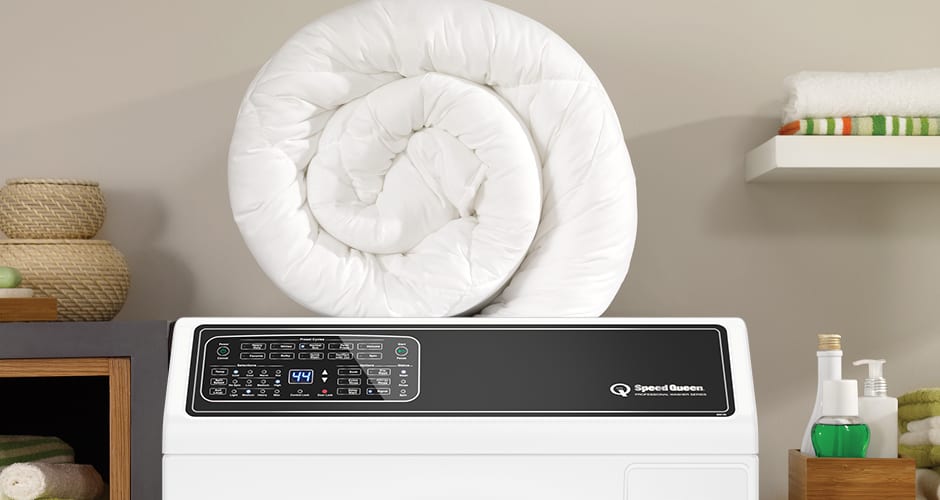Looking at your bedspread and wondering how to wash a comforter without making it lumpy? And wondering whether it will fit? Or maybe it’s been a while since your pillows had a good clean. Perhaps your kids went camping and now you need to know how to wash a sleeping bag.
Washing big, bulky items can be tricky. Read on for answers to four common questions to make cleaning those oversized items easier.
1. Is it better to take bulky items to the dry cleaner?
Whether it’s an oversized comforter or king-sized pillow, most materials are safe to throw in the wash. But always check the care label instructions to make sure your oversized item is machine washable.
For example, you may be wondering if your down comforter can be washed at home.
One common misconception people have is that a down comforter can’t have water on it. However, many down comforters are safe for machines. On the other hand, if you have a wool or silk comforter, water and/or heat can damage and shrink it.
2. What machine settings should I use?
Use the cold water setting on your bedding and other oversized items for a gentler wash. Hot water can make colors fade or run. The extra rinse setting is also a good idea, because it ensures the detergent completely washes out of the bulkier material.
When it’s time to dry, put your dryer on a low heat or no heat setting – this keeps the filling from clotting together and ruining the smooth evenness.
You may notice your comforter, sleeping bag or pillow isn’t fully dry once you pull it out of your dryer. In that case, either hang it up and let it air dry for a day or run it through your dryer one more time.
3. How often should I wash my bulky items?
Wash your comforters two to three times a year. Good Housekeeping says an easy reminder is washing them when the seasons change.
Pillows should be washed about every three months. When washing pillows, you want to make sure your washing machine stays balanced. Typically, you load two pillows at a time to keep it balanced, but if you have two king-sized pillows and a small capacity washer, you may need to stick with just one. In that case, you can maintain balance by loading a smaller blanket on the other side.
For other oversized items, like sleeping bags or stuffed animals, it just depends on your personal preference and how often you use them. Sometimes simple spot work will do the trick.
4. How do I keep my items from getting lumpy?
First of all, make sure your washing machine has a large enough capacity to give items like a comforter, pillow or sleeping bag plenty of room to tumble around. If you have to stuff it in with no extra room, a laundromat would be a safer option.
Every half hour, remove your items from the dryer to fluff them by hand. This helps keep their filling evenly distributed. You can also add a few tennis balls to the dryer, which will evenly batter against the filling to keep it from clumping up.
Make washing oversized laundry an easy task.
With answers to common questions about washing oversized laundry and a few other tips for making it easier, you’ll be able to get all your comforters and pillows washed with no hassle.
Here’s a few more bonus tips to keep in mind before you wash one of your sizeable laundry items:
- Remove the duvet cover and double-check to make sure your pillow doesn’t have a zip-on cover so you can wash them separately.
- If your pillows look slightly dingy or yellow, add the recommended amount of bleach to your washer (according to your model’s instructions) to help whiten them up.
- Take a quick look at your items to make sure there isn’t any loose stitching. You don’t want them coming apart in your washer or dryer.
Washing pillows, comforters and other oversized items don’t have to make laundry harder. With a few adjustments to your usual routine, you can have bulky items washed and dried easily.


